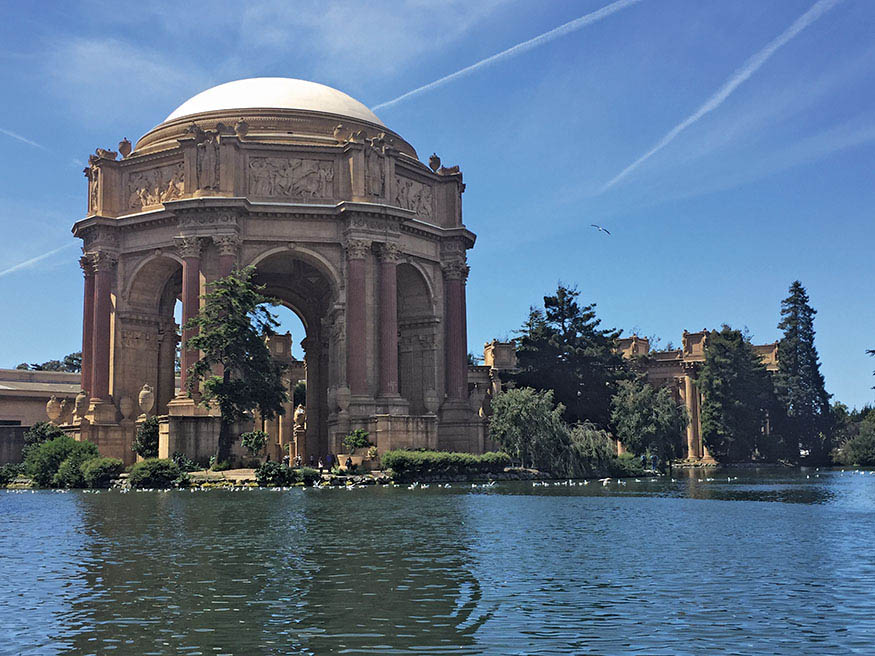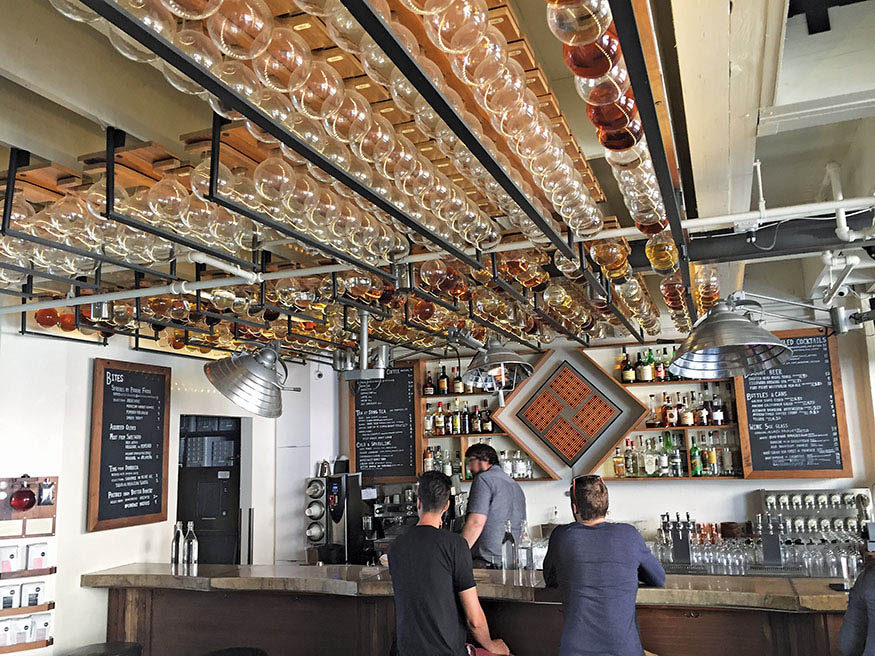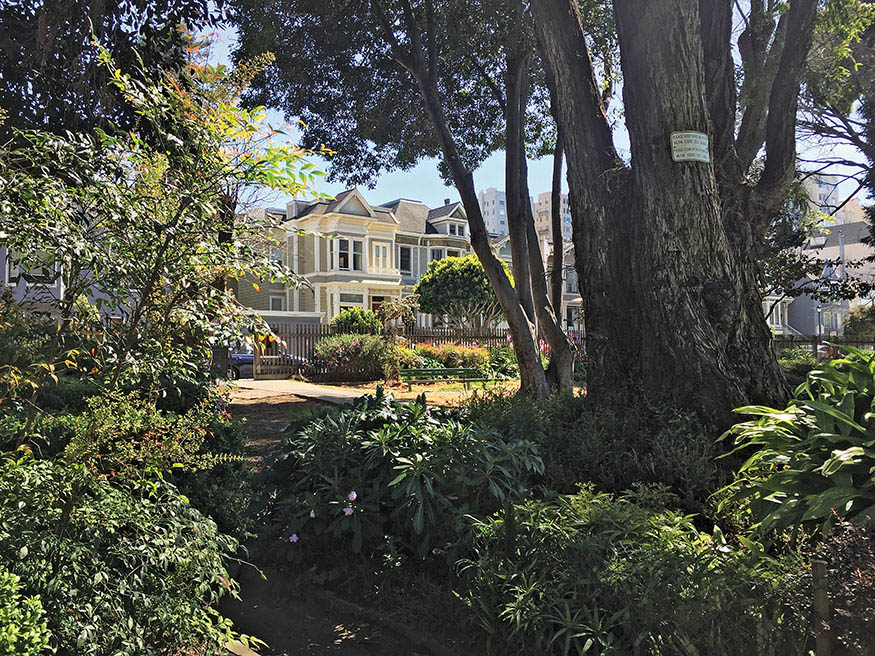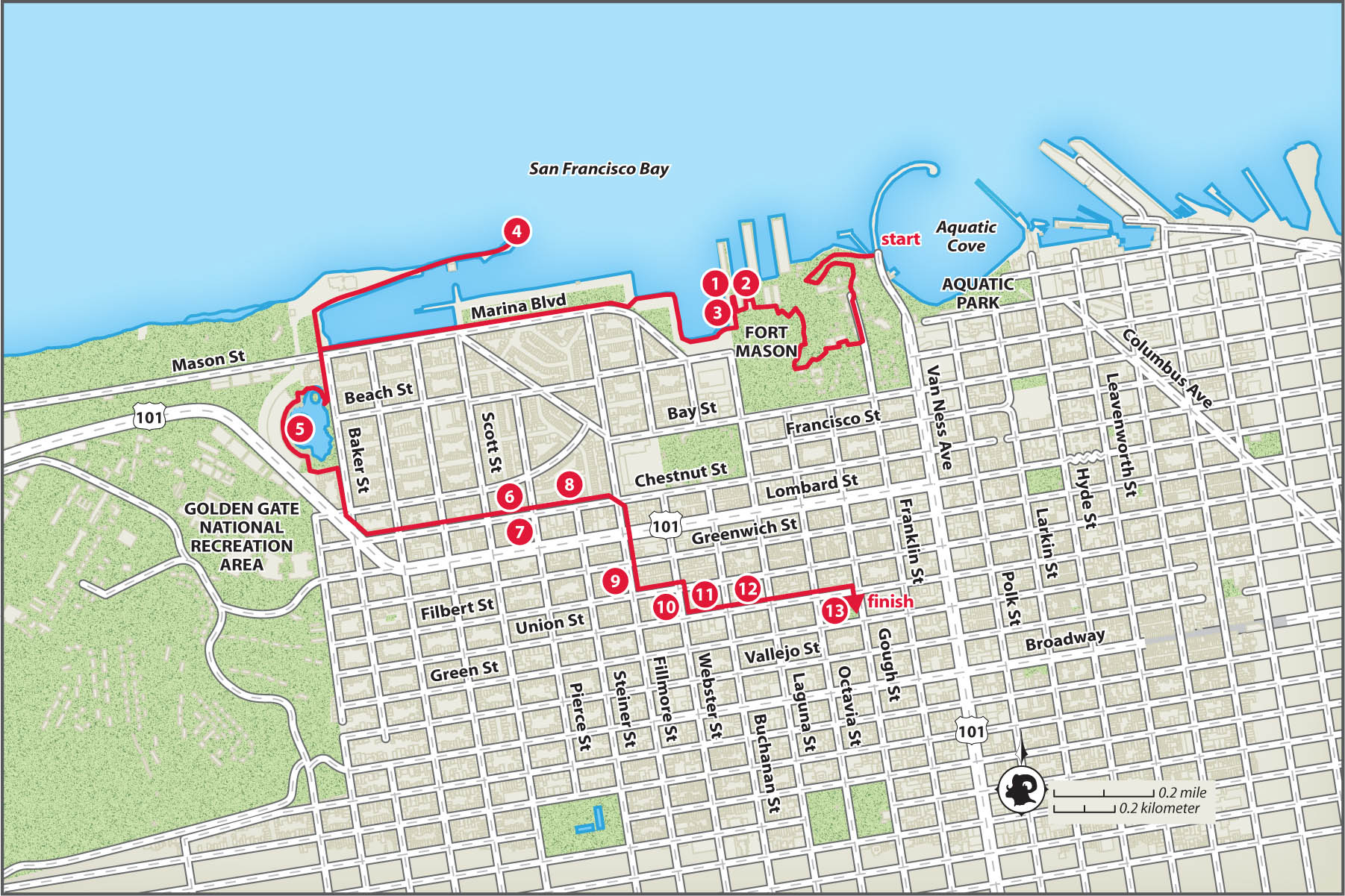
Marina and Cow Hollow Lifestyles of the Young and Beautiful |

A placid lagoon surrounds the faux ruins of the Palace of Fine Arts.
BOUNDARIES: Van Ness Ave., Baker St., Green St., and San Francisco Bay
DISTANCE: 3.5 miles
DIFFICULTY: Moderate (some stairs)
PARKING: Off-street parking in Fisherman’s Wharf is your best bet.
PUBLIC TRANSIT: Powell–Hyde cable car; 30, 47 Muni buses
The Marina might be summed up as the new-money counterpart to old-money Pacific Heights (see Walk 18). Both are upper-class enclaves, but while Pacific Heights rises above the city with a Victorian regalness, the Marina thrusts its chest out into the bay with a 20th-century brashness. Cow Hollow, being neither up the hill nor along the bay, more or less slides into the Marina, and the two neighborhoods feel like two parts of a whole.
Single professionals have been drawn to the area since the yuppies of the 1980s claimed the neighborhood. You’ll encounter young urban professionals throughout the city, but those in Marina and Cow Hollow still seem to be of their own special stripe. The districts are remarkably mainstream, at least by San Francisco standards. The city’s countercultural leanings are little felt here, but the waterfront is postcard perfect. On this walk we’ll set out to appreciate the Marina’s location with a brisk hike along the bayfront before looping back down the commercial Main Streets of both neighborhoods.
Start at Aquatic Park, just beyond the end of Van Ness, where a paved footpath follows the curve of a rare bayside beachfront. Follow the path toward (but not onto) the eyelash-shaped pier; then go left on McDowell Road and follow the ramp up to Fort Mason. (The FORT MASON BAY TRAIL sign tells you that you’re on the right track.) Toward the top of the hill, make a left on Battery and then unmarked Bunker Road to walk behind the youth hostel, and look for the dirt path on your left that leads to the 1863 Black Point Battery and Civil War–era cannon in the grass. So far, the cannon has never been fired in hostility—let’s hope it stays that way. This promontory became a defensive battery way back in 1797, when the Spanish established Battery San Jose here.
Follow the trail past the cannon, and then look for concrete stairs leading up on your right. At the top of the steps, a concrete path leads into the residential part of Fort Mason. The fine Victorian houses along the east side of Franklin Street were originally built for civilians. Although the military always owned the land, as the city grew quickly in the 1850s developers went ahead and built homes here, in what was then known as Black Point. It was a gamble worth taking, for the front-row views of the bay from the bluffs here are spectacular. Eventually, these homes housed military officers. The large building on the left, at the corner of Franklin Street and MacArthur Avenue, is the Fort Mason Officers’ Club.
Nothing against officers, but head in the opposite direction, crossing in front of the chapel. You’ll soon reach the visitor center, where you can grab maps and literature for future visits to the Golden Gate National Recreation Area (GGNRA), of which Fort Mason is a part. Past the visitor center, look for the blacktop path that wends through the green of the Great Meadow. In one corner, before a grassy amphitheater, a statue of the late congressman Phillip Burton appears to be orating. Burton chaired a subcommittee on national parks and increased the amount of protected parkland in the United States during the late 1970s.
Turn right and follow the path across the Great Meadow staying right until you see a large green placard and a set of stairs leading down to the lower half of Fort Mason. Three piers and five whitewashed wooden warehouses, built circa 1915, remain from what used to be the US’s largest embarkation port on the Pacific, from the Spanish-American War on through to World War II. During the 1960s, as the military began shutting the fort down, Congressman Burton set his sights on creating a national park, the GGNRA, to include these scenic bluffs and historic buildings. The sheds today house an assortment of cultural, nonprofit, and culinary institutions, including the renowned Magic Theatre, which has premiered works by Sam Shepard and David Mamet, among others. Also here is  Greens, one of the most critically acclaimed vegetarian restaurants in the country. Founded by the Zen Center of San Francisco, Greens opened in 1979. If it’s mealtime, you can grab a healthy sack lunch and find a spot on the piers for a picnic. Also while here, take a look inside the San Francisco Museum of Modern Art’s Artists’ Gallery, where works by contemporary artists are exhibited and sold. Then duck into the
Greens, one of the most critically acclaimed vegetarian restaurants in the country. Founded by the Zen Center of San Francisco, Greens opened in 1979. If it’s mealtime, you can grab a healthy sack lunch and find a spot on the piers for a picnic. Also while here, take a look inside the San Francisco Museum of Modern Art’s Artists’ Gallery, where works by contemporary artists are exhibited and sold. Then duck into the  Readers Bookstore, where the Friends of the San Francisco Public Library sell the library’s cast-off and donated books and movies at bargain prices; the adjacent Goody Café serves coffee and baked goods. One of the newest and coolest members on the scene at Fort Mason is
Readers Bookstore, where the Friends of the San Francisco Public Library sell the library’s cast-off and donated books and movies at bargain prices; the adjacent Goody Café serves coffee and baked goods. One of the newest and coolest members on the scene at Fort Mason is  The Interval at Long Now, a self-described bar, café, museum, and home to the Long Now Foundation, whose mission is “to creatively foster long-term thinking and responsibility in the framework of the next 10,000 years.” Even if you aren’t parched, take a peek inside to check out their 10,000-year clock, the bottle reserve hanging from the ceiling, and the “ambient painting” by Brian Eno that hangs behind the bar. You may want to return for one of their salon lectures on topics that range from climate change to robots.
The Interval at Long Now, a self-described bar, café, museum, and home to the Long Now Foundation, whose mission is “to creatively foster long-term thinking and responsibility in the framework of the next 10,000 years.” Even if you aren’t parched, take a peek inside to check out their 10,000-year clock, the bottle reserve hanging from the ceiling, and the “ambient painting” by Brian Eno that hangs behind the bar. You may want to return for one of their salon lectures on topics that range from climate change to robots.

The 10,000-year clock inside The Interval at Long Now assures ample time to belly up to the bar.
From Fort Mason, an asphalt path rounds a small yacht harbor before meeting the sidewalks of the Marina Green, a long, gusty lawn along the bayshore that’s perfect for kite flying. As the flatness of the terrain here makes apparent, much of the Marina is landfill, created shortly before and directly after the 1906 quake. Some of the fill is said to be rubble from buildings toppled during the quake—ironic considering that buildings on landfill are particularly vulnerable during earthquakes. Liquefaction occurs as the earth beneath the streets is shaken, turning the ground beneath foundations into jelly. This was cruelly borne out during the 1989 Loma Prieta earthquake, which inflicted more damage on the Marina than on any other part of the city.
The Marina Green is a long, uneventful stretch, so just enjoy the view and the exercise. You’ll likely be passed by joggers, scooters, skaters, cyclists, soccer players, Frisbee tossers, in-line skaters, and dog walkers. The sailing craft moored in the harbor here belong to members of the exclusive St. Francis Yacht Club, founded in 1927, and the Golden Gate Yacht Club, founded 12 years later. The landfill and the harbor here were completed in time for the 1915 Panama-Pacific International Exposition, which ostensibly celebrated the opening of the Panama Canal. Of course, the fair also demonstrated the reemergence of San Francisco, just nine years after the city was laid to waste, and it promoted the new patch of real estate that would soon become the Marina District. Strange and exotic buildings covered much of the fairgrounds, only to be torn down immediately afterward. The Mediterranean-style housing you see here now mostly went up in the 1920s.
The Marina Green sidles along Marina Boulevard for several blocks. At Baker Street, turn right and then right again onto Yacht Road. Follow the road all the way to the end to reach the  Wave Organ, an unusual example of environmental art, sponsored by the Exploratorium. Built by artist Peter Richards and mason George Gonzales in 1986, the Wave Organ is constructed of PVC pipe and busted headstones salvaged from a dismantled graveyard. The idea is to appreciate the sounds created by the tides passing through the pipes. Press an ear against the listening tubes that poke up out of the cobblestones—each one sounds different. The rumbling tones have a profound hush, like an amplified seashell. There’s even a stereo booth, with various sounds coming at you from several tubes. The Wave Organ sounds best during high tide, which sometimes occurs at an unaccommodating time of day. (Check the website saltwatertides.com to see a tidal timetable for the day of your walk.) At lower tides, the sound emanating from the tubes resembles the chugging and wheezing of an old toilet. Still, it’s unusual enough to warrant an out-of-the-way side trip, and it’s a beautiful setting regardless of the sound.
Wave Organ, an unusual example of environmental art, sponsored by the Exploratorium. Built by artist Peter Richards and mason George Gonzales in 1986, the Wave Organ is constructed of PVC pipe and busted headstones salvaged from a dismantled graveyard. The idea is to appreciate the sounds created by the tides passing through the pipes. Press an ear against the listening tubes that poke up out of the cobblestones—each one sounds different. The rumbling tones have a profound hush, like an amplified seashell. There’s even a stereo booth, with various sounds coming at you from several tubes. The Wave Organ sounds best during high tide, which sometimes occurs at an unaccommodating time of day. (Check the website saltwatertides.com to see a tidal timetable for the day of your walk.) At lower tides, the sound emanating from the tubes resembles the chugging and wheezing of an old toilet. Still, it’s unusual enough to warrant an out-of-the-way side trip, and it’s a beautiful setting regardless of the sound.
Return to Marina Boulevard and turn left on Baker Street. A block up, the stately pillars of Bernard Maybeck’s  Palace of Fine Arts reflect off a duck pond. The palace, designed to look like a gutted classical ruin, is the only architectural showpiece spared after the Panama-Pacific International Exposition. When it was up for demolition, Phoebe Hearst, philanthropist and mother of William Randolph Hearst, swept in to save it,. The original, made of plaster and chicken wire, wasn’t designed to last, but it was faithfully rebuilt of durable concrete in the 1960s and then made seismically sound in 2009. The lagoon plays host to swans, migrating ducks, and turtles, while the grounds are the scene of weddings, prom photos, and innumerable selfies.
Palace of Fine Arts reflect off a duck pond. The palace, designed to look like a gutted classical ruin, is the only architectural showpiece spared after the Panama-Pacific International Exposition. When it was up for demolition, Phoebe Hearst, philanthropist and mother of William Randolph Hearst, swept in to save it,. The original, made of plaster and chicken wire, wasn’t designed to last, but it was faithfully rebuilt of durable concrete in the 1960s and then made seismically sound in 2009. The lagoon plays host to swans, migrating ducks, and turtles, while the grounds are the scene of weddings, prom photos, and innumerable selfies.
Stay on Baker until you reach Chestnut Street, where a left turn eventually leads into a fashionable shopping strip. Among the expensive clothiers and training centers are a handful of spots to grab a cup of coffee or a bite to eat, as well as the old Presidio Theater, which still shows first-run films.  Tacolicious, an immensely popular locally sourced take on tacos, started as a takeout stand in the ferry building. After acquiring a cult following, they opened their first store here on Chestnut. While it has moved locations, the crowds have followed, multiple Bay Area outposts have sprung up, and a cookbook has been published. Across the street, cozy
Tacolicious, an immensely popular locally sourced take on tacos, started as a takeout stand in the ferry building. After acquiring a cult following, they opened their first store here on Chestnut. While it has moved locations, the crowds have followed, multiple Bay Area outposts have sprung up, and a cookbook has been published. Across the street, cozy  Books Inc. is an outpost of the West’s oldest independent bookseller, having provided the written word to the masses since 1851. This location opened in 1998, and an exceptionally friendly staff, notable author events, and a wide-ranging supply of titles have made it a neighborhood draw. A few blocks up,
Books Inc. is an outpost of the West’s oldest independent bookseller, having provided the written word to the masses since 1851. This location opened in 1998, and an exceptionally friendly staff, notable author events, and a wide-ranging supply of titles have made it a neighborhood draw. A few blocks up,  Lucca Delicatessen has all the hallmarks of a great Italian deli, with the aroma of salamis and cheeses luring you in. There’s a park ahead, if you want to grab a sandwich to go.
Lucca Delicatessen has all the hallmarks of a great Italian deli, with the aroma of salamis and cheeses luring you in. There’s a park ahead, if you want to grab a sandwich to go.
At Fillmore Street turn right. After crossing busy Lombard Street, you enter Cow Hollow. As the name suggests, this was once home to dairy farms and vegetable gardens. A block down, the  Balboa Cafe welcomes you to the neighborhood. It’s a great old bar and grill, open since 1913, with an interior that would look right at home in an Edward Hopper painting. The etched numbers over the door read 1914, but we haven’t made a typo: the original owners were superstitious about the number 13 and so chose to date themselves a year older. Over lunch you can enjoy the place for its historical atmosphere, but be warned that at night the neighborhood’s noisy singles scene engulfs it. On the yuppie-socialite map during the 1980s and still a hot spot today, Balboa Cafe is now part of former mayor Gavin Newsom’s PlumpJack wine ventures.
Balboa Cafe welcomes you to the neighborhood. It’s a great old bar and grill, open since 1913, with an interior that would look right at home in an Edward Hopper painting. The etched numbers over the door read 1914, but we haven’t made a typo: the original owners were superstitious about the number 13 and so chose to date themselves a year older. Over lunch you can enjoy the place for its historical atmosphere, but be warned that at night the neighborhood’s noisy singles scene engulfs it. On the yuppie-socialite map during the 1980s and still a hot spot today, Balboa Cafe is now part of former mayor Gavin Newsom’s PlumpJack wine ventures.
Turn left on Filbert. At the corner of Webster Street,  Vedanta Temple is one of the most exotic-looking places of worship in San Francisco and is the first Hindu temple in the Western Hemisphere. The Victorian pile is a purple flight of fancy with Moorish arches and turrets. It was built in 1905 by Swami Trigunatitananda, the Hindu monk who founded the Vedanta Society of Northern California. The swami explicitly specified the creation of the five domes, each of which represents a different religion or emulates a temple (including the Taj Mahal) to create an overall sense of universality. And truly his vision of unity seems very San Francisco in its vibrant eclecticism. Turn right on Webster Street to admire it from all sides.
Vedanta Temple is one of the most exotic-looking places of worship in San Francisco and is the first Hindu temple in the Western Hemisphere. The Victorian pile is a purple flight of fancy with Moorish arches and turrets. It was built in 1905 by Swami Trigunatitananda, the Hindu monk who founded the Vedanta Society of Northern California. The swami explicitly specified the creation of the five domes, each of which represents a different religion or emulates a temple (including the Taj Mahal) to create an overall sense of universality. And truly his vision of unity seems very San Francisco in its vibrant eclecticism. Turn right on Webster Street to admire it from all sides.
A block farther down Webster make a left on Union Street, the main drag. Nearly everything on Union speaks to a privileged lifestyle, where you can wax, peel, brush, and contour away any blemishes when not whiling away the hours shopping for expensive activewear. The pinnacle of this indulgent lifestyle would be  Le Marcel, a specialty bakery for dogs, featuring homemade hypoallergenic birthday cakes and bonbons for the mutt in your life. If the thought of this drives you to drink,
Le Marcel, a specialty bakery for dogs, featuring homemade hypoallergenic birthday cakes and bonbons for the mutt in your life. If the thought of this drives you to drink,  Perry’s, at No. 1944, can come to the rescue. The bar has the feel of an old New York tavern, and indeed it moved here from the Upper East Side in 1969. Most of the time it’s a casual neighborhood joint where you can watch a few innings of baseball over a beer and a burger. Late at night, though, Perry’s becomes more of a singles-mingle meat market.
Perry’s, at No. 1944, can come to the rescue. The bar has the feel of an old New York tavern, and indeed it moved here from the Upper East Side in 1969. Most of the time it’s a casual neighborhood joint where you can watch a few innings of baseball over a beer and a burger. Late at night, though, Perry’s becomes more of a singles-mingle meat market.
Turn right on Gough for a look at the  Colonial Dames Octagon House at No. 2645. Built in 1861, the house was actually constructed across the street but it had fallen into disrepair from neglect when the Colonial Dames of America purchased it and moved it for restoration. At first not much was known about the house or its earliest occupants, but in 1953 an electrician was doing renovation work and stumbled upon a tin canister hidden by the original owners under the stairs. William and Harriet McElroy had stashed a time capsule that included newspaper clippings, an ambrotype photo of the family, and letters that solved the mystery. See the Russian Hill tour (Walk 11) for background on unusual eight-sided houses such as this one. Next to it is wooded Allyne Park, surrounded by an unpainted picket fence—a good spot to get off your feet after a long walk. Van Ness Avenue is just two blocks away.
Colonial Dames Octagon House at No. 2645. Built in 1861, the house was actually constructed across the street but it had fallen into disrepair from neglect when the Colonial Dames of America purchased it and moved it for restoration. At first not much was known about the house or its earliest occupants, but in 1953 an electrician was doing renovation work and stumbled upon a tin canister hidden by the original owners under the stairs. William and Harriet McElroy had stashed a time capsule that included newspaper clippings, an ambrotype photo of the family, and letters that solved the mystery. See the Russian Hill tour (Walk 11) for background on unusual eight-sided houses such as this one. Next to it is wooded Allyne Park, surrounded by an unpainted picket fence—a good spot to get off your feet after a long walk. Van Ness Avenue is just two blocks away.

Cow Hollow’s peaceful Allyne Park affords plentiful shade and benches for resting tired feet.

Marina and Cow Hollow
Points of Interest
 Greens Fort Mason Center, Landmark Building A, 2 Marina Blvd.; 415-771-6222, greensrestaurant.com
Greens Fort Mason Center, Landmark Building A, 2 Marina Blvd.; 415-771-6222, greensrestaurant.com
 Readers Bookstore Fort Mason Center, Landmark Building C, 2 Marina Blvd; 415-771-1076
Readers Bookstore Fort Mason Center, Landmark Building C, 2 Marina Blvd; 415-771-1076
 The Interval at Long Now Fort Mason Center, Landmark Building A, 2 Marina Blvd.; 415-496-9187, theinterval.org
The Interval at Long Now Fort Mason Center, Landmark Building A, 2 Marina Blvd.; 415-496-9187, theinterval.org
 Wave Organ 83 Marina Green Dr.; 415-528-4444, exploratorium.edu/visit/wave-organ
Wave Organ 83 Marina Green Dr.; 415-528-4444, exploratorium.edu/visit/wave-organ
 Palace of Fine Arts 3301 Lyon St.; 415-563-6504, palaceoffinearts.org
Palace of Fine Arts 3301 Lyon St.; 415-563-6504, palaceoffinearts.org
 Tacolicious 2250 Chestnut St.; 415-649-6077, tacolicious.com
Tacolicious 2250 Chestnut St.; 415-649-6077, tacolicious.com
 Books Inc. 2251 Chestnut St.; 415-931-3633, booksinc.net/sfmarina
Books Inc. 2251 Chestnut St.; 415-931-3633, booksinc.net/sfmarina
 Lucca Delicatessen 2120 Chestnut St.; 415-921-7873, luccadeli.com
Lucca Delicatessen 2120 Chestnut St.; 415-921-7873, luccadeli.com
 Balboa Cafe 3199 Fillmore St.; 415-921-3944, balboacafe.com
Balboa Cafe 3199 Fillmore St.; 415-921-3944, balboacafe.com
 Vedanta Temple 2963 Webster St.; 415-922-2323, sfvedanta.org
Vedanta Temple 2963 Webster St.; 415-922-2323, sfvedanta.org
 Le Marcel 2066 Union St.; 415-440-2498, lemarceldogbakery.com
Le Marcel 2066 Union St.; 415-440-2498, lemarceldogbakery.com
 Perry’s 1944 Union St.; 415-922-9022, perryssf.com
Perry’s 1944 Union St.; 415-922-9022, perryssf.com
 Colonial Dames Octagon House 2645 Gough St.; 415-441-7512, nscda-ca.org/octagon-house
Colonial Dames Octagon House 2645 Gough St.; 415-441-7512, nscda-ca.org/octagon-house